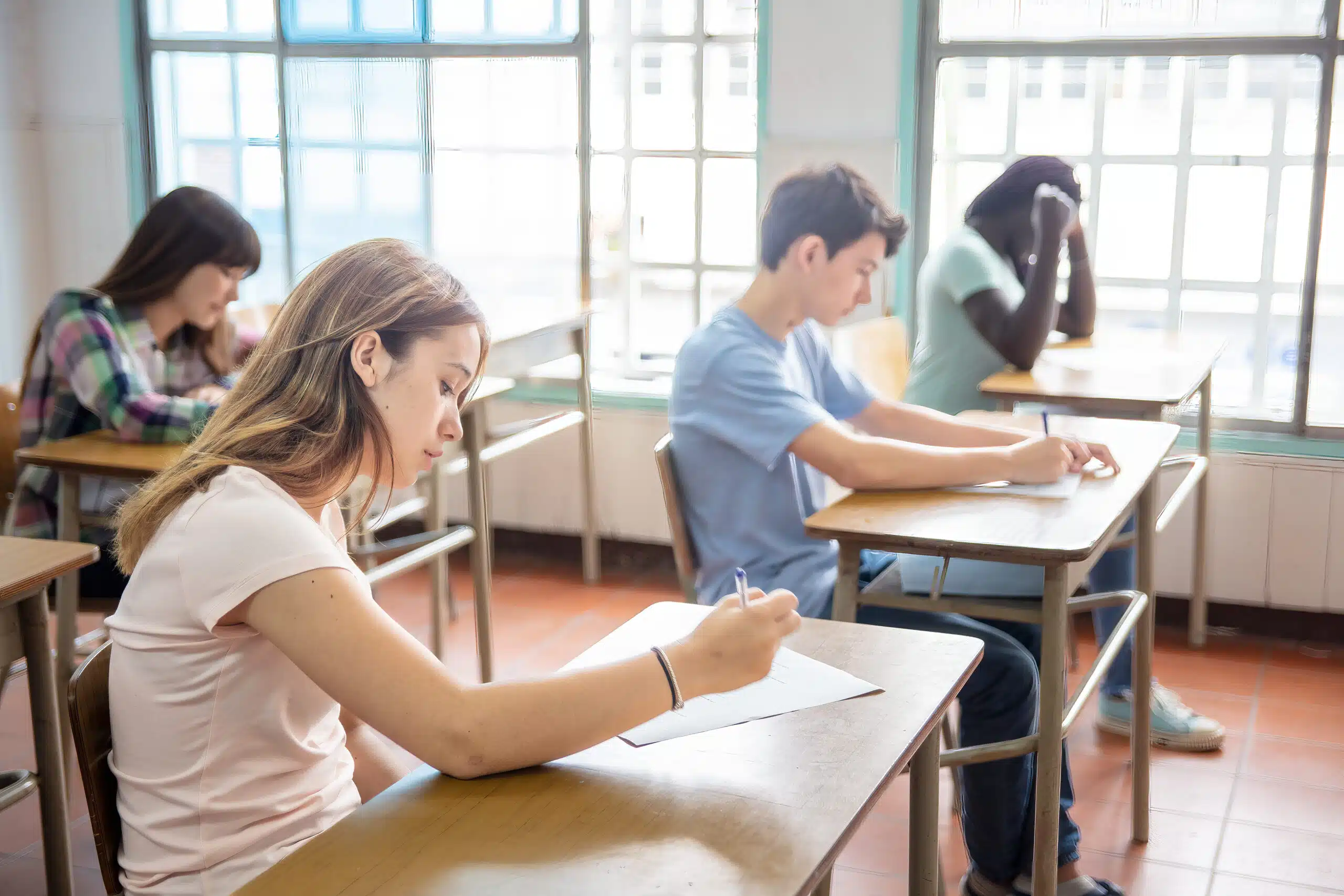Obsessive-Compulsive Disorder – An Up-Close Look at the Anatomy of OCD
When people hear the term obsessive-compulsive disorder, they often think of someone who fixates on things to the point of detriment. Perhaps they cannot leave a room without turning a light switch on and off a specific number of times. Maybe they must have pictures or other items organized in a particular way (by color or size, for example). Or maybe, they must wash their hands over and over despite not being in any way dirty. Portrayals of people with obsessive-compulsive disorder in the movies are often stigmatizing and sometimes inaccurate; however, these images are what people take as fact when they hear their child or a loved one has obsessive-compulsive disorder. There are many things about the illness that are misunderstood, and therefore, parents sometimes do not realize their teen’s symptoms are treatable and manageable.
Learn more about our adolescent OCD treatment or call us now at 888-254-0916.
What is Obsessive-Compulsive Disorder?
Obsessive-Compulsive disorder is characterized by unwanted, repetitive thoughts (obsessions) and irrational, excessive urges to do certain things (compulsions). Obsessive-compulsive order goes well beyond checking the front door to see if it is locked or the oven to make sure it is off. A teen who meets the diagnostic criteria for obsessive-compulsive disorder feels an overwhelming compulsion to repeatedly act out certain rituals or habits. Although many people with obsessive-compulsive disorder know their thoughts, behaviors, and actions do not make logical sense, they are often unable to stop them even if the actions complicate their day-to-day lives in unnecessary or detrimental ways.
Take our free OCD test today.
What are the Symptoms of Obsessive-Compulsive Disorder?
Obsessive-compulsive disorder is characterized by specific obsessions, thoughts, and compulsive behaviors. In general, these thoughts and behaviors last more than an hour each day and interfere significantly with daily life.
Obsessions
Obsessions are thoughts or impulses that repeatedly occur. They are frequently upsetting and result in significant anxiety if they are not addressed. A teen with obsessive-compulsive disorder may try to ignore or suppress these thoughts. Still, the fear associated with the idea the thoughts could “come true” makes ignoring them difficult, if not impossible. Eventually, the fear and anxiety associated with obsessive thoughts make the teen engage in compulsive behaviors to decrease their fear and anxiety.
Compulsions
Compulsions are repetitive acts that temporarily relieve the fear, stress, and anxiety brought about by an obsession. When someone struggles with obsessive-compulsive disorder, they adopt compulsions because they believe these ritual behaviors or actions will prevent something terrible from happening.
When someone struggles with obsessive-compulsive disorder, their thoughts and compulsions often cause stress and anxiety. No matter how hard one tries to ignore them, they usually keep coming back.
Understanding the Types of Obsessive-Compulsive Disorder
Obsessive-compulsive disorder can present in different ways. Although to date, there is no official classification or “subtypes” of obsessive-compulsive disorder, there is research to suggest people experience symptoms in four main categories: cleaning and contamination, symmetry and order, forbidden, harmful, or taboo thoughts and impulses, and hoarding. These groups of symptoms are described in detail in the recent edition of the Diagnostic and Statistical Manual of Mental Disorders (DMS-5). Your teen’s treatment provider at Beachside may refer to them as symptom dimensions rather than symptom subtypes or categories.
Like many mental illnesses, not every teen will experience obsessive-compulsive disorder in the same way. Specific symptoms may be similar from person to person, or they can vary widely. Also, it is possible to experience symptoms for more than one dimension or “type” of obsessive-compulsive disorder. A teen living with obsessive-compulsive disorder will likely experience a range of symptoms, often from one or more dimensions.
Cleaning and Contamination
Common symptoms from this dimension may include persistent worry about germs or sickness, persistent fears about exposure to viruses or other sources of contamination, compulsions to clean or wash, and specific cleaning or washing rituals.
Symmetry and Ordering
These symptoms may involve an overwhelming need for belongings to be aligned in a certain way, an extreme need for symmetry, feeling incomplete when things are not in order, counting rituals, or organization rituals.
Forbidden Thoughts
This dimension encompasses a variety of thoughts that can be overwhelmingly difficult to manage. Examples include intrusive thoughts that are often sexual or violent, persistent questioning of sexual orientation and desire, constant worry that you’ll harm yourself or someone else, concerns about causing bad things to happen, and frequently revealing your day-to-day activities to ensure you haven’t hurt anyone. This particular dimension of obsessive-compulsive disorder often involves obsessions and intrusive thoughts with minimal outwardly visible compulsions.
Hoarding
In the context of obsessive-compulsive disorder, hoarding is different than hoarding disorder which is a separate mental health condition. The primary difference between the two is the distress involved with hoarding-related obsessive-compulsive disorder. Unline a hoarding disorder; someone with obsessive-compulsive hoarding does not necessarily want the things they collect. However, they feel compelled to save them because of the nature of their obsessive or compulsive thoughts. Examples in this dimension include persistent worry that throwing something away could bring harm, a need to collect a certain number of items for protection, fear of throwing away an essential item by accident, difficulty throwing things away because touching them could cause contamination, or a compulsion to check or review your possessions to make sure nothing has been lost.
Risk Factors and Causes of Obsessive-Compulsive Disorder
To date, it is not entirely understood why some teens develop obsessive-compulsive disorder. However, there are multiple theories about possible causes. The first is family history. Someone is more likely to develop obsessive-compulsive disorder if a family member also has the condition. It is believed that specific genes play a role in the development; however, they have yet to discover which particular genes “cause” obsessive-compulsive disorder. Also, it is important to note that not all people with obsessive-compulsive disorder happy family member who shares the condition.
Another possible cause is related to biology. Some research has suggested that brain chemistry might be a contributing factor. Impaired function in certain parts of the brain or problems transmitting certain brain chemicals could contribute to disease development.
Similar to many other mental health disorders environments may also be a critical contributing factor. It is possible that abuse, trauma, or other stressful events may play a part in obsessive-compulsive disorder development.
Diagnosis and Treatment
If you are concerned your teen could be struggling with obsessive-compulsive disorder symptoms, reach out to your primary care provider or a mental health care provider here at Beachside. A mental health provider will ask your teen about the types of symptoms they experience, whether they cause distress, and how much time their compulsions take up each day. A diagnosis of obsessive-compulsive disorder often requires that symptoms affect your teen’s day-to-day functioning and consume an hour or more of their day. A mental health provider here at Beachside will also take note of the group of symptoms your teen experiences as not all treatment programs and models for obsessive-compulsive disorder have the same benefits for all symptoms.
Mental health professionals generally consider a combination of therapy and medication as the most beneficial treatment for obsessive-compulsive disorders. Exposure and response prevention (ERP), a type of cognitive-behavioral therapy, is generally the most recommended treatment approach. This type of treatment gradually exposes your teen to subjects of their obsessions or things that cause compulsions. Working in the safety of a therapeutic setting, your teen can learn how to deal with the discomfort they experience when they do not complete their compulsions. They will practice these skills and learn healthier coping mechanisms, but they can take with them into the post-treatment environment.
Suppose your teen has severe obsessive-compulsive disorder symptoms or their symptoms do not respond to therapy alone. In that case, it is possible their mental health care provider may recommend medication to be used in conjunction with their therapeutic program. Depending on their unique needs and circumstances, they may take the medication for just a short time (during therapy) or a longer duration both during and post-treatment. Generally, medications that are the most beneficial for obsessive-compulsive disorders include antidepressants and antipsychotics. The most helpful medication and treatment for obsessive-compulsive disorder can sometimes depend on symptoms specifically. Some research has found evidence to suggest that some symptom dimensions respond better to one class of medication over another. Similarly, specific treatment models or sometimes more effective for one treatment symptom class than for another.
It is not uncommon for everyone to experience minor obsessive or compulsive symptoms from time to time. Intrusive or fixative thoughts are also common. However, if your teen experiences obsessions compulsions that take up more than an hour of their day or their symptoms get in the way of the things they need and want to do, it may be time to consider reaching out to the mental health team here at Beachside. Without treatment, obsessive-compulsive disorder symptoms may worsen over time, eventually having a detrimental impact on your teen’s relationships and quality of life. With treatment, however, symptoms often improve.
At Beachside, we understand deciding to seek treatment for your teen is not easy. Therapy in and of itself can bring about feelings of anxiety and distress. Choosing to send your teen to treatment away from home is a difficult decision. Research has shown the best outcome for teens (and adults) with obsessive-compulsive disorder symptoms involves comprehensive, evidence-based therapies in a setting equipped to manage the unique nature of teen mental health treatment. If your teen is struggling with obsessive-compulsive disorder symptoms that are hindering their ability to live their best life, don’t wait another day to reach out to our caring and compassion at the team here at Beachside. Let our admissions staff tell you more about how our teen-focused treatment programs can help your teen learn how to manage their symptoms and begin a new life free of debilitating obsessions and compulsions.
Resources




